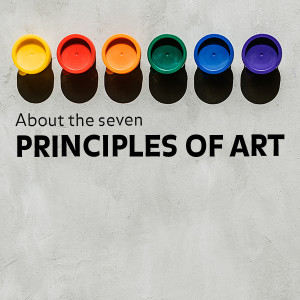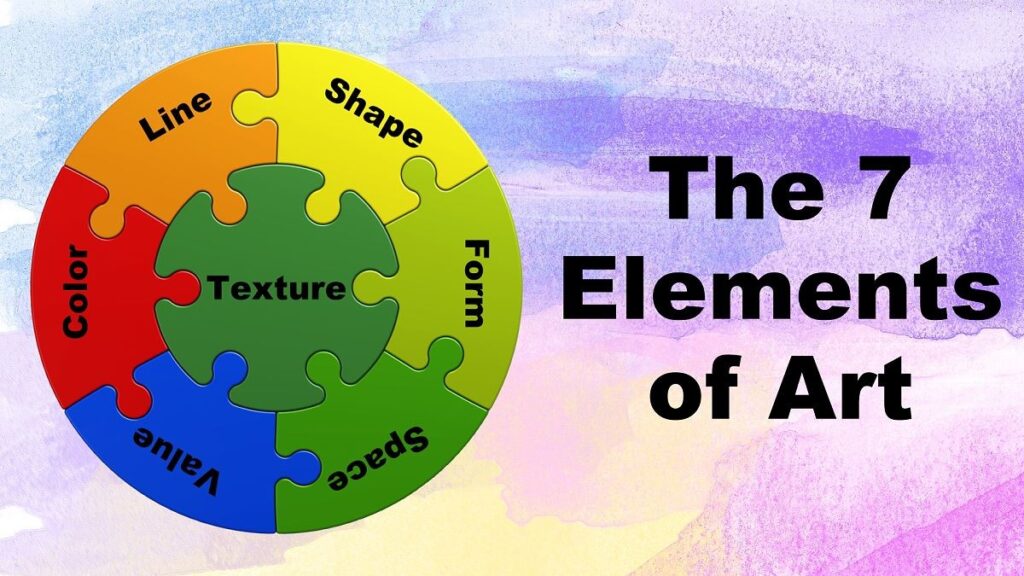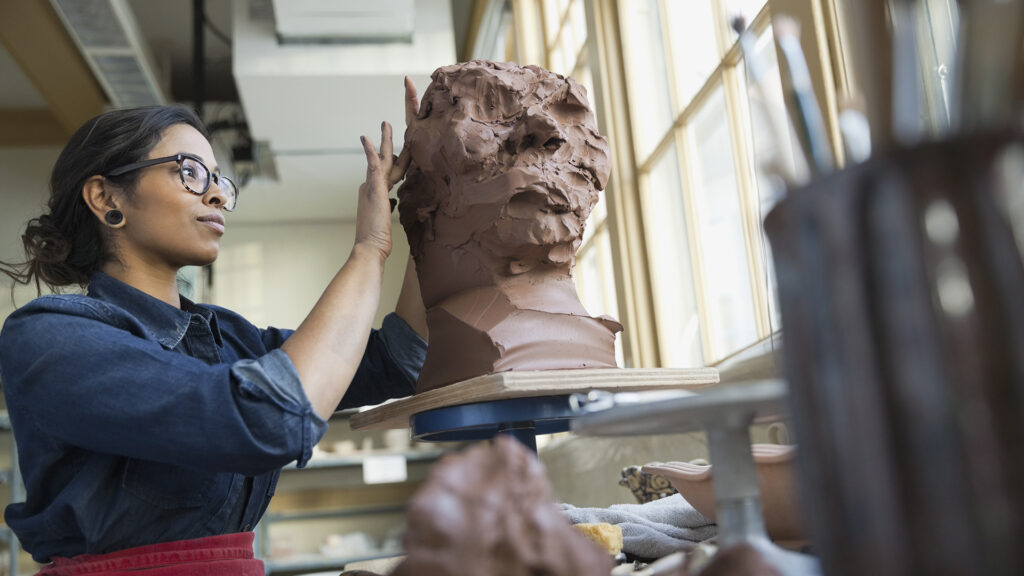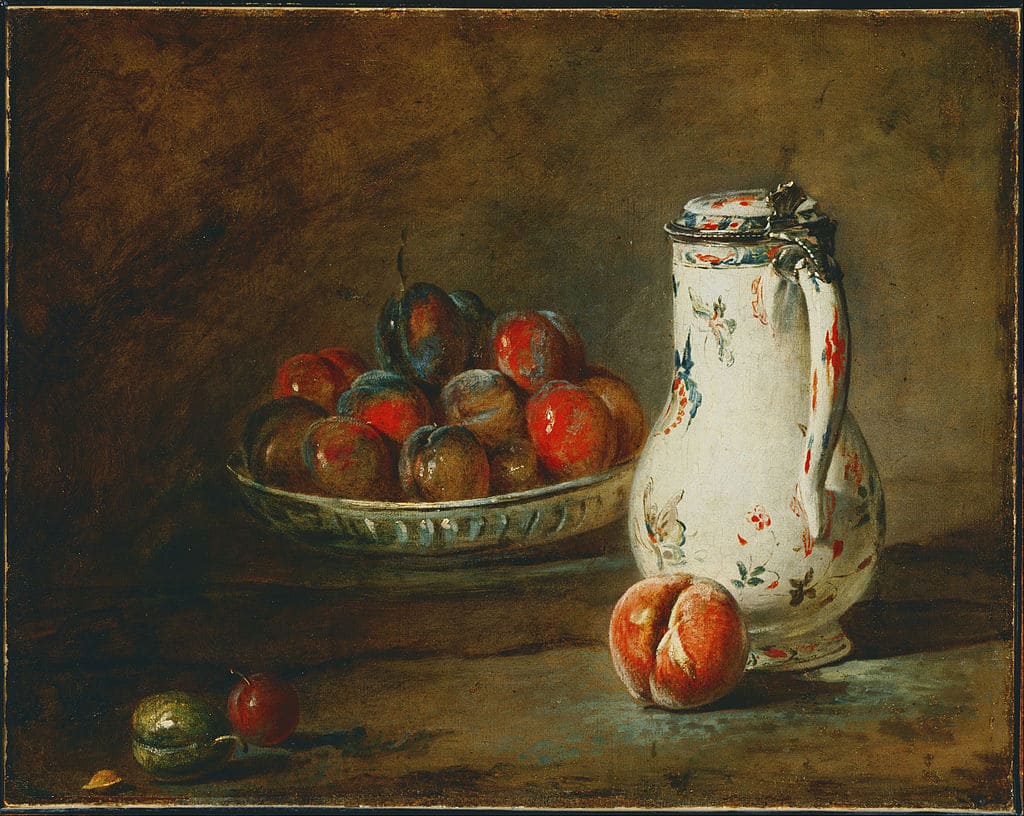Emphasis in art is like putting a spotlight on something important.
When artists want you to really notice a certain part of their artwork, they use emphasis. This means making that part stand out more than the rest.
Imagine you’re looking at a painting, and your eyes are drawn straight to a bright red flower in the corner – that’s emphasis in action!
It’s all about guiding your eyes to what the artist wants you to see. There are five main ways artists do this: through color, contrast, size, placement, and repetition.
Let’s explore some famous artworks to see how emphasis works in real life.
What is Emphasis in Art?

Emphasis in art is like spotlighting in a play. It’s about making certain parts of the artwork stand out more than others, grabbing your attention and guiding your eyes around the piece.
Artists use different tricks to create emphasis, like making something bigger, bolder, or brighter than everything else, or placing it in a strategic spot. This highlighted part is called the focal point. It’s like the star actor on stage – the main attraction.
Sometimes, an artist might choose not to emphasize anything in particular, especially in abstract or pop art, where everything seems to have equal importance. But even in these cases, the lack of emphasis can be a deliberate choice, a way for the artist to convey a message.
So, emphasis isn’t just about what stands out, but also about what doesn’t. It’s all about creating a balance that guides the viewer’s eyes and emotions through the artwork.
7 Principles of Art

Emphasis is one of the principles of art, not elements of art. You can learn about each principle of art and element of art in the linked articles below:
- Balance
- Contrast and Emphasis (we are reading about emphasis now!)
- Movement and Rhythm
- Unity and Variety
- Harmony
- Pattern
- Proportions and Scale
7 Elements of Art

Why is using Emphasis in Art Important?

Emphasis in art is like the spotlight on a stage. It directs your eyes to what the artist wants you to see, making sure you don’t miss the main message or story of the artwork.
Think of a painting of a beautiful landscape. Without emphasis, your eyes might wander aimlessly across the canvas, not knowing where to settle.
But with emphasis, perhaps through bold colors or strong contrasts, the artist can draw your attention to the majestic mountains in the distance or the vibrant sunset in the sky.
Emphasis isn’t just about pointing out the main thing; it’s also about creating a journey for your eyes to follow. By strategically emphasizing certain elements, artists can guide you through their work, revealing layers of meaning or emotion along the way.
Ultimately, emphasis adds depth and purpose to art. It’s the difference between seeing and truly experiencing a piece, allowing both the artist and the viewer to connect on a deeper level.
How to Use Emphasis in Art?

An artist can create emphasis in art through one of several ways: contrast, convergence, separation or isolation, exception, subordination and location.
Contrast
Emphasis in art is crucial for guiding the viewer’s attention to the focal point of a piece. One effective method to achieve this is through contrast.
Color plays a significant role in creating emphasis through contrast.
For instance, using complementary colors, such as purple and yellow, immediately draws attention due to their stark differences on the color wheel.
Similarly, employing isolated color, where one color stands alone in the composition, or absent color, where one object is colored while the rest is monochrome, can also make elements stand out.
Value, which refers to the lightness or darkness of tones, can also be utilized to create emphasis. Placing lighter values or muted tones strategically within the artwork can direct focus to specific areas, such as a brightly lit subject or a shaded spot.
Overall, by employing these techniques of contrast, artists can effectively emphasize key elements within their artwork, guiding the viewer’s attention and creating visual interest.
Separation/Isolation
Emphasis in art is like making something really pop out and grab your attention.
One way to do this is by separating or isolating the main subject from everything else. It’s like putting a spotlight on it. By leaving lots of empty space around the main subject, you’re making it stand out even more.
This technique tricks our brains into focusing on what’s separate or isolated, making it the star of the show. It’s like saying, “Hey, look at this!” without any distractions.
So, if you want to make something in your art really stand out, try giving it some space to shine on its own.
Creation of Exception/ The Unusual
Using emphasis in art involves drawing attention to certain elements within an artwork. One way to do this is by creating exceptions or unusual focal points.
Imagine you’re playing chess and instead of the usual rectangular pieces, there’s one odd blob-shaped piece on the board. That blob stands out because it doesn’t follow the typical rules of the game.
Similarly, if you draw a cow on the moon, it’s unexpected and grabs your attention because it’s out of place.
These unusual choices disrupt our expectations and make us pause to take notice. So, creating exceptions or unusual elements can be a playful and effective way to add emphasis in art.
Convergence
Emphasis in art is like spotlighting the star of the show.
One way to do this is through convergence. Think of convergence as using lines, shapes, or even how objects are placed to guide our eyes to the main focal point of the artwork.
Now, how does it work? Well, artists can use different tricks. They might draw things in a way that makes our eyes naturally follow a path, like using perspective to make objects look smaller as they get farther away. Or they could position objects strategically, like having a person facing a certain direction, making us look that way too.
Even the use of light and dark can play a role. Lighter areas can draw our attention more than darker ones, so artists might use lighter tones to guide us toward what they want us to see.
Subordination
Emphasis in art is all about drawing attention to a specific focal point within an artwork.
One way to do this is through a technique called subordination. This means making everything else in the artwork less important compared to the focal point.
You can achieve subordination using different elements like color, value (how light or dark something is), texture, and space.
For example, you might use bold colors or darker shades to make the focal point stand out while keeping the rest of the artwork more subdued.
Another technique is rendering or detailing. This means adding more intricate details or making the main subject of the artwork more polished compared to the background or other elements.
So, to use emphasis in art effectively, you can play with these techniques to make your focal point really pop and grab the viewer’s attention.
Location
When you’re making art, where you put things on the canvas can make a big difference. This is called “location emphasis.” It’s about deciding where the main stuff in your artwork goes.
There are some rules artists follow for this. One is the “rule of thirds.” Imagine your canvas divided into nine equal parts with two equally spaced horizontal lines and two equally spaced vertical lines. According to this rule, the main subjects of your art should be where these lines intersect.
Another rule is the “golden mean,” which is a bit more complicated mathematically, but it’s similar to the rule of thirds in practice.
But sometimes, it’s okay to put your main subject right in the middle. Just know that when you do this, it really draws attention to that one thing, and everything else might not get noticed as much. So, it’s a choice you make depending on what you want people to focus on in your art.
Tips for Creating Emphasis in Art

Here are some of the design elements artists use to create emphasis in their art:
Color
Artists use color in strategic ways to create emphasis.
If they plan to encourage a viewer’s eye to progress slowly from one area of the work to another, they may use soft, subtle colors that change gradually.
This can create a gradient effect that leads to the focal point. Artists also use color to convey emotion and relay the piece’s meaning.
Some artists might use various combinations of colors to emphasize a particular part of their piece. Blue and orange are an example of a complementary color pairing.
Proportion
Creating emphasis in art can be achieved through various techniques, and one powerful way is by playing with proportion.
Instead of sticking to the usual sizes we’re used to seeing, artists sometimes exaggerate or distort proportions to grab attention and make a point.
For instance, imagine a sculpture where the person’s head is much larger than usual.
This kind of exaggeration can prompt viewers to ponder deeper meanings, like the immense power of the human intellect.
So, in essence, tweaking proportions can really make art stand out and convey powerful messages.
Repetition
One way to make something stand out in art is through repetition.
This means using the same thing over and over again in a piece. When you repeat colors, shapes, or other elements, it makes them seem more important and draws attention to them.
It’s like saying, “Hey, look at this!” This technique gives a sense of movement or activity in the artwork, making it more engaging for the viewer.
So, if you want to create emphasis in your art, try repeating certain elements to make them pop!
Alignment
In art, creating emphasis is like highlighting the important parts of a story.
One important way to do this is through alignment. Think of alignment like arranging things neatly in a cupboard or lining up words in a document.
It helps to create a flow and unity in the artwork, making it easier for people to understand the overall idea.
Artists might play with alignment intentionally, using things like asymmetry instead of perfect balance to draw attention to certain parts of their work.
So, just like how organizing things helps in daily life, alignment in art helps guide the viewer’s focus and convey the artist’s message or feeling.
Proximity
To make things stand out in art, think about how close or far apart they are. That’s what “proximity” is all about.
Back in the 1900s, some smart psychologists figured out that when things are close together, our brains like to see them as one big group, even if they’re different. Artists use this trick by putting things close together that they want you to notice.
So, when you see shapes, colors, or textures all bunched up, your brain says, “Hey, look at this!” It’s like magic that makes things pop in a picture.
Balance
In art, making things stand out is important for grabbing attention and creating impact.
One way artists do this is by using balance. They might make things symmetrical or use similar shapes and colors to create a sense of harmony.
When you see something off-kilter in a piece of art, your eyes are naturally drawn to it. Artists might even add a focal point within that unbalanced area to make it even more noticeable.
So, balance isn’t just about making everything look even, it’s also about making certain things pop and catch your eye.
How to Get Started with Emphasis in Your Own Artwork?

To begin emphasizing in your own artwork, follow these steps:
- Choose an idea for the artwork: First, think about what you want your art to express. Consider the emotions or message you wish to convey. Simplify your concept into a single sentence. This will help you focus on what’s important.
- Decide your focal point(s): Determine what elements of your artwork will stand out the most. Remember the five ways we discussed earlier: size, color, contrast, isolation, and placement. Consider using one or a combination of these techniques to highlight your chosen emotion or message. Sketch out your ideas and experiment with different variations. Choose the one that best achieves your desired effect.
- Create!
Remember, practice makes perfect! Keep experimenting and refining your techniques to develop your own unique style of emphasis in your artwork. Pay attention to details and make adjustments as needed to ensure your message comes across clearly.
FAQ’s:
What is Art Principle Emphasis?
Emphasis is an art principle that creates a focal point with the help of different art elements.
Why do Artists use Emphasis in Art?
Artists use emphasis in art to convey a message or alter their viewers’ opinions on subjects they have paid attention to.
What are the Five Ways in Which you can Create Emphasis in Art?
Convergence, contrast, subordination, separation, and the creation of exceptions are the five ways in which you can create emphasis in art.
What are the Best Examples of Emphasis in Art?
The Last Supper, Christina World, and some of Claude Monet’s artworks make the best examples of emphasis in art.
Conclusion
In conclusion, emphasis in art serves as the guiding light that directs our gaze, evokes emotions, and tells stories within the vast canvas of creativity.
Through techniques like contrast, isolation, convergence, and more, artists skillfully orchestrate focal points, drawing us into their narratives with precision and purpose.
Just as a spotlight illuminates the stage, emphasis highlights the essence of art, ensuring that every stroke, color, and form contributes to a captivating visual symphony.
So, whether it’s the bold strokes of a Renaissance masterpiece or the subtle nuances of a contemporary piece, emphasis remains a timeless principle, inviting us to explore, interpret, and appreciate the intricate tapestry of human expression.


Leave a Reply